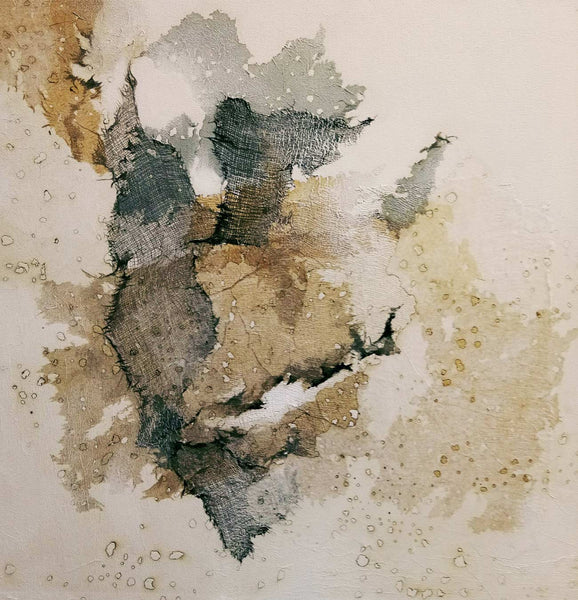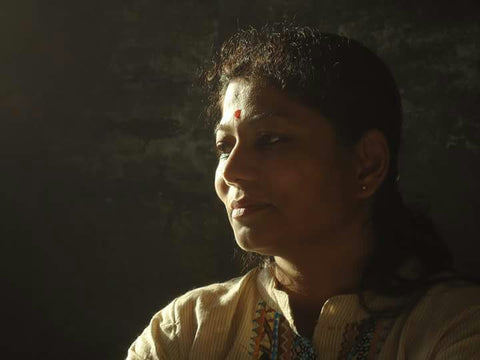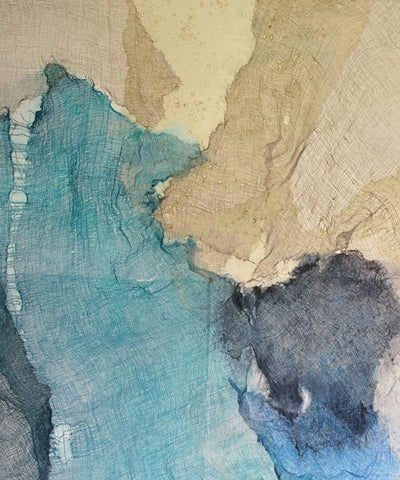Art is Meditation for Abstract Artist Madhuri Kathe
“I don’t paint,”, she says, on being asked about the process she follows before enlivening a blank canvas. It throws us off, until Madhuri Kathe, an artist renowned for her stunning abstract creations, elaborates, “I just play with colours, and the paintings come to be.” This statement alone, tells you about the artist’s spiritual rootedness; a way of life that guides her art and reflects in her creations.

Madhuri Kathe grew up listening to doctrines of saints such as Lord Vithala, Sant Dnyaneshwar and Sant Tukaram. Her father was an avid reader of their philosophy. Over time, her interests in these subjects grew, and it is this influence that is evident in her artistic and spiritual evolution.
Abstract was not always Madhuri’s chosen artistic style. Until 2000, she mostly created figurative works. But as her understanding of the spiritual world grew deeper, her focus shifted from figurative to abstract. She believes that a “higher source” guides her fluid strokes. And in fact, even the way Madhuri uses medical gauze (a highly unique medium) to create her art, has a spiritual predisposition.
 (Artwork by Madhuri Kathe, click to purchase on Artisera)
(Artwork by Madhuri Kathe, click to purchase on Artisera)
Process
For Madhuri, filling an empty canvas is not a deliberate process. Listening to classical music, reading philosophies of scholars and meditating, put Madhuri in a blissful state and trigger her inventiveness. Her relationship with the canvas is spontaneous. “There is no defined start or dictated end when I work. I simply paint my moods, emotions and visions, as I see and feel them. I know an artwork is complete when the canvas tells me so,” she explains.
The spontaneity continues with how Madhuri Kathe employs medical gauze to construct texture in her art. Sharing details of her creative process, she explains, “I affix the gauze on the canvas using special glues from China or Korea. The colour play starts after that. It is exciting to see how the gauze absorbs and throws out different acrylic paints. Sometimes, I dye the gauze in one or more colours before using it. Once it’s placed on the canvas, I observe where the colours flow and stop, when they interact with the gauze. The uncertainty of how the different materials will react with one another, is what creates magic. This entire process evokes a sense of euphoria in me.”

In recent times, Madhuri has taken a fancy to other interesting materials that she sources during her travels, such as tissues, organic paper and handmade paper - Korean hanji being one of them. These are always used in tandem with the gauze. She either burns the papers or drills holes into them, before positioning them on the canvas. This play with textures is what characterizes her abstract art and makes it so unique.
 (Artwork by Madhuri Kathe, click to purchase on Artisera)
(Artwork by Madhuri Kathe, click to purchase on Artisera)
Philosophy
Madhuri Kathe has an interesting perspective on what art is. According to her, it is a vivid reflection of the inner beauty of the cosmos. “Artists are born with the gift to look beyond the façades around us, and to show the world the inner beauty of the universe,” she muses.
Madhuri firmly believes that the viewer’s interpretation of art reverberates the artist’s emotions. Feelings experienced at the time of choosing the colours, making the textures, the flow, the sentiments - all these vibrations should be felt by the viewer. If, when looking at her abstract art, Madhuri’s audience feels the same joy she did while painting, she deems it an achievement of her artistic expression.
To Madhuri, art is a ruminative, internal process. Talking about the increased commercial pressure on artists today, the artist, true to her philosophy, doesn’t endorse the concept of creating art based exactly on given specifications. “My creations are first for myself, and then for the buyer. Selling art is the secondary part of my work,” she says, with quiet confidence.

Palette
God’s most incredible creation – nature – is a source of continuous inspiration to Madhuri Kathe. She recalls times when she has spent hours observing the plants in her studio. From the shedding of green leaves to the sprouting of buds to hints of pink in the veins, they have all inspired her to create art using these colours.
In what Madhuri considers a significant period in her journey as an artist, she spent several weeks at a prestigious art residency in Sweden in the summer of 2018. The country’s breathtaking winter landscape, with its haunting iciness, prompted her to use a lot of whites and blues in her creations.
In fact, Madhuri’s palette usually gravitates towards the use of sea green, blue, purple, pale yellow and burnt orange - soft hues that she associates with a sense of calm.
 (A viewer admiring Madhuri Kathe's artworks at the Sweden Residency)
(A viewer admiring Madhuri Kathe's artworks at the Sweden Residency)
Past
If you ask Madhuri what she would be if she weren’t an artist, she laughs. Because art is all she can remember from her youngest days. Since the age of five, doodling in her books was of more interest to Madhuri than taking notes during school. “Drawing just made me happy — I used to lose myself in my sketches. My teachers knew I was not paying attention to the subjects being taught, but they appreciated my talent. And my father strongly supported and encouraged my artistic endeavours,” she recalls.
Seeing potential in his daughter, Madhuri’s father introduced her to the late Padma Shri Dr. Vishnu Shridhar Wakankar, an internationally recognised artist and archeologist. She was 11 at the time. “At his art institute in Ujjain, I studied ancient objects, coins, rock architecture and rock paintings,” say Madhuri. She then went on to earn a Master’s degree in Drawing and Painting from Vikram University in Ujjain, and another Master’s in Ancient Indian History and Archaeology. She finished her education with a PhD in Miniature Paintings.
Between studying with Dr. Wakankar and earning a PhD, Madhuri became a mentee of Dr. OP Bhatnagar. She trained with him for 12 years, right after completing high school. She wished to move to Mumbai to study in the prestigious JJ School of Arts. However, she didn’t get admission in the institution. “At that time, my guru, Dr. Bhatnagar told me not to leave Ujjain to go to an art school. He said he saw a natural artist in me and would chisel my life. He had a lot of expectations from me as an artist. I learnt so much from him, and from all my gurus in different phases of my life,” she admits.
 (Artwork by Madhuri Kathe, click to purchase on Artisera)
(Artwork by Madhuri Kathe, click to purchase on Artisera)
Madhuri’s confidence as an artist grew as her pieces started gaining recognition at art shows — one of them was at Mumbai’s Bajaj Art Gallery in 1992. However, this wasn’t her first show. It was during her time with Dr. Wakankar, that Madhuri’s work first gained public exposure. “In 1984, Dr. Wakankar took my paintings to Boston to display them in a group exhibition there,” she remembers. The artist was only too gratified to be the youngest in the group, and to have her work shown internationally. “After that, my passion, or madness, whatever you call it, soared,” says Madhuri. And since then, she has participated in numerous shows and residencies in India and abroad.
As is evident from her thoughts, art for Madhuri Kathe has been a steady journey, much like life. While studying under some greats of the art world has influenced her, it is her philosophical learnings that have played an enormous role in shaping Madhuri’s methods. “I have a deep understanding of spiritual practices, and you’ll always find their influences in my work. I believe in ‘nirankar’, which means formlessness, or abstract. And that is a philosophy that guides all my paintings.”























































































